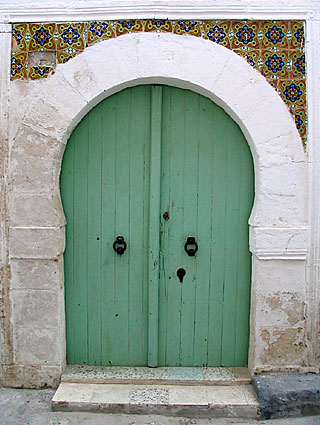
Sahel
The Arabic name ‘Sahel’ means coast or margin. In the case of the sub-Saharan Sahel it is the margin of the desert, but in Tunisia it is the little bulge in its east coast.
Ranging back from the east coast these fertile plains have long been the heartland of the country’s agriculture and an important power base – both Habib Bouguiba and Ben Ali come from this region, and it contains Sfax, the country’s most prosperous city.
As far as the tourist is concerned the region’s main jewel is Kairouan, the country’s spiritual capital. However, for this little travelogue I am going to concentrate on its other jewels, the towns of Sousse, Sfax, Monastir and Mahdia.
Sousse rivals Hammamet as the centre of the tourist industry in Tunisia. This is evidenced by the continuous strip of hotels stretching from the city northward for many miles. In the past the tourists baking in the sun and enjoying the soft white sand were in the main Germans. Lately however, they seemed to have been usurped by the British and the East Europeans seeking bargain basement prices for 4 star hotels with 1 star food and service. These hotels are all much of a muchness but I would recommend one restaurant – l’Escargot – which serves excellent French food in a delightful environment. It is opposite the collection of Hana hotels in the town centre.

This is the Hotel Hana International in Sousse and where we stayed for a few days. As in most of Tunisia, the place to stay is in a big package tour-type hotel like this because they are billed as 4 or 5 star and are incredibly cheap – compared to other similar starred hotels throughout the world (especially offseason i.e. outside June- Sep). Unfortunately most of these hotels are now a bit frayed at the seams and the service and food is uniformly bad. Having said that, you can’t beat staying at a place like this for £10 a night.
Sousse is not just a strip of hotels and a tourist trap however. The medina or old Arab city is full of interest and has a host of interesting medieval buildings such as the Great Mosque, Ribat (monastic fortress) and Kasbah (Administrative centre/fort) which contains a very interesting museum and great views over the city. In addition its narrow maze of alleys hide a number of interesting old buildings, souks (covered markets) and the usual souvenir shops.

A little down the coast, Monastir is growing into another huge tourist centre. There are ever growing numbers of package-deal hotels filling up the beach space between the own and Sousse. It even has the second busiest airport in the country constantly loading and unloading pre-tanned and tanned tourists and shuffling them to and from their hotels. The town itself has also been transformed as if for the tourists. The area around its two great monuments – the Ribat and Habib Bourguiba’s mausoleum has been totally razed and so the place has a sort of fake Disneyland feel to it, with non of the rough and readiness of some of the other Tunisian towns. Having said that it is still very picturesque and pleasant for a wander, especially the two fine buildings noted above.
Outside view of the Ribat at Monastir. Originally this was in the centre of a thriving medina, but all the adjoining houses were razed in order to show off this fine monument.
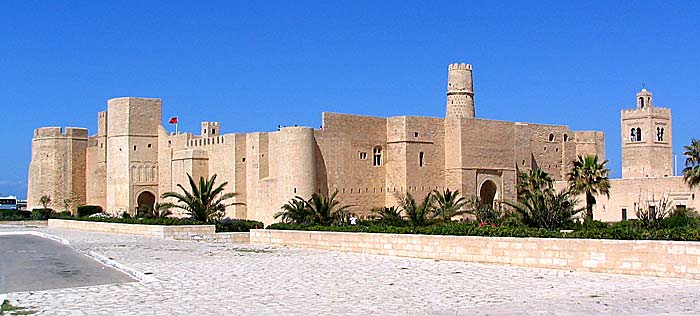
The Ribat at Monastir. As you can see it has been renovated so much that even historians cannot age many parts of it. It is still quite an impressive building however and may remind visitors or the many films that have used this backdrop including Zeffirelli’s Jesus of Nazareth and Monty Python’s Life of Brian.
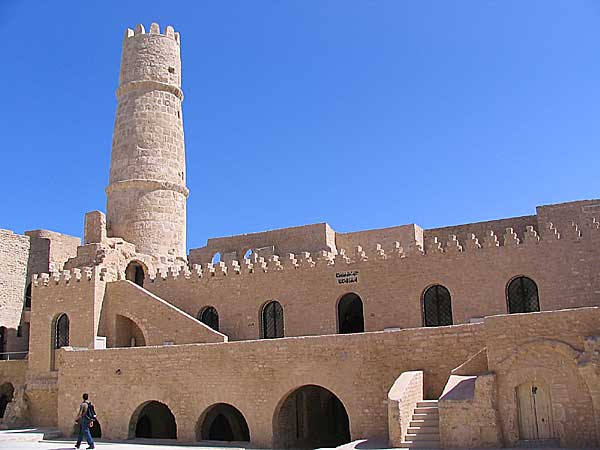

View to Habib Bourguiba’s mausoleum

The mausoleum itself

40kms further around the coast is Mahdia and although tourism is stretching its tentacles this way, at the moment it remains relatively unspoilt. The old city (the medina) is much smaller than its Sahelian counterparts, but retains a certain pride. There are fewer alleys and old buildings to explore but it is more a place of reflection, to enjoy the peace and quiet and soak up the light and colour of the place in one of the delightful cafes. Perhaps sharing a table with some of the old men in the Place du Caire enjoying the shade of the fig trees.

Mahdia is famous for its Skifa el Kahla gate: ‘the Dark Passage’. The gate stood in the middle of a 10m thick wall which protected the city until the Spaniards destroyed it in 1554.

Although Mahdia isn’t as disfigured as most ancient Tunisian towns by stores selling tourist tat, it still has items for sale which are seen everywhere. In this case the Janissary puppets. These crude dolls are modelled on Turkish soldiers which date back to the Ottoman rule.
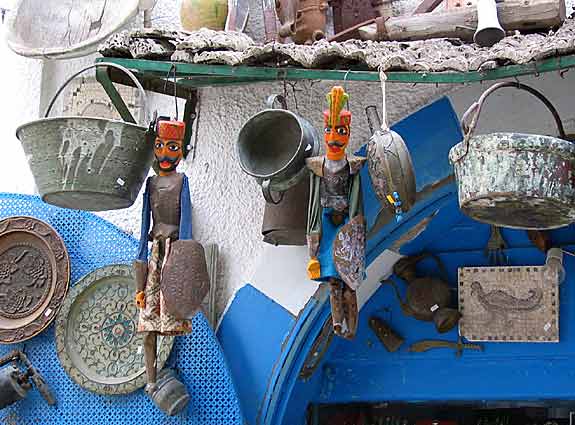
Most of the fishermen in Mahdia have rowng boats to fish and use the interesting method of pulling one oar while pushing the other. Usually the fishermen have one oar each but obviously here one of them is taking a breather.
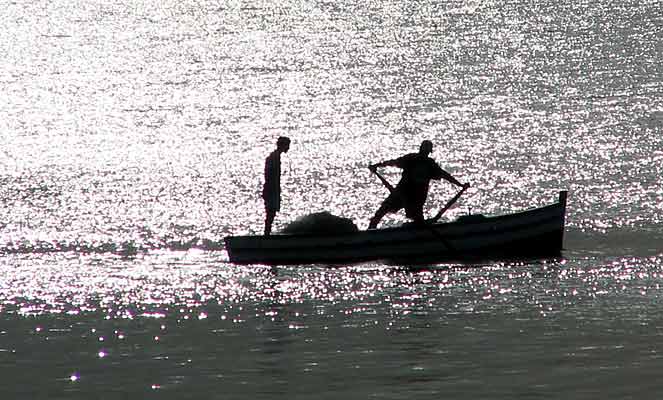
The women in Tunisia outside of the main cities dress rather conservatively and are often seen in these all-over white garments. these ladies are off to work on the famous looms of Mahdia.
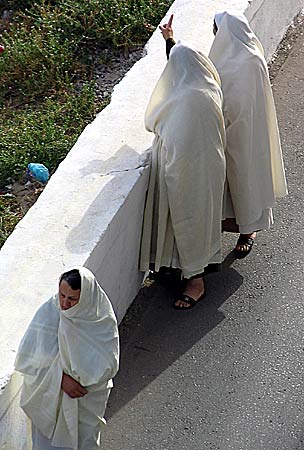
It is also one place where you don’t have to stay in a big tourist hotel a few kms out of town. The Hotel Jazira is a small Bed and Breakfast within the old town and is only a few metres from the sea. I was tempted to cast a line out from my bedroom window to join the other fishermen who were close by in their rowing boats.

Another highlight of Mahdia is going for a sunset walk around the rocky peninsula. Here are the remains of a port built by the Fatimids in the 10th century and now used by local fishermen to tie up their rowing boats. It is surrounded by a sprawling cemetery, itself a botanist’s delight with many wild flowers carpeting the graves and meandering paths.
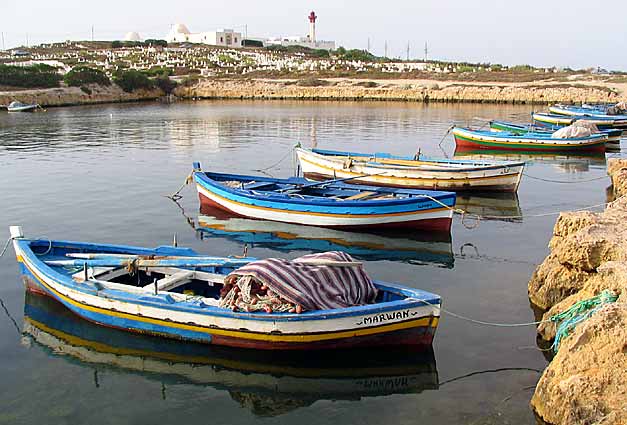
Heading inland from Mahdia we come to El Jem. In fact a number of dead straight roads seem to converge on this little town. Not surprising I suppose as its main claim to fame is Roman and that of its huge amphitheatre nestled in the centre of this small Sahelian town. Built around 300AD, the amphitheatre is better preserved and not much smaller than its more illustrious counterpart in Rome, the Colosseum. Estimates of its original capacity run to 30,000 – much more than the present or past population of the town. There is also an interesting museum not far from the amphitheatre if you can follow the signs around the back streets for a kilometre or two, containing a number of interesting mosaics and the remains of a Roman house.
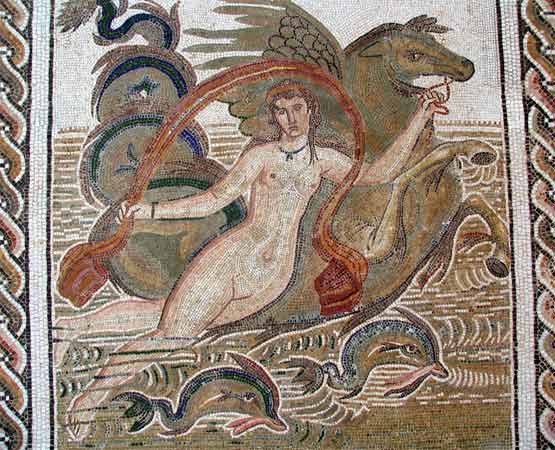
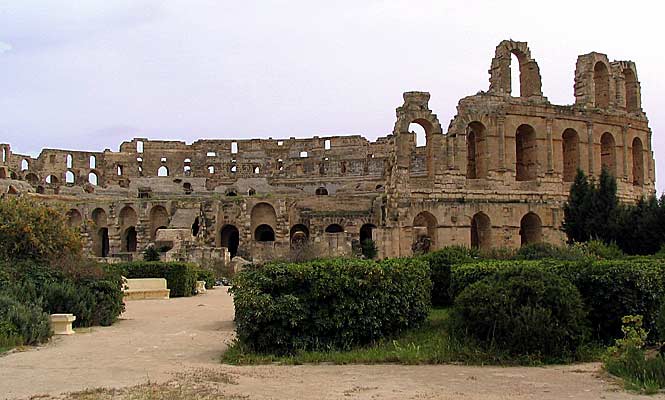
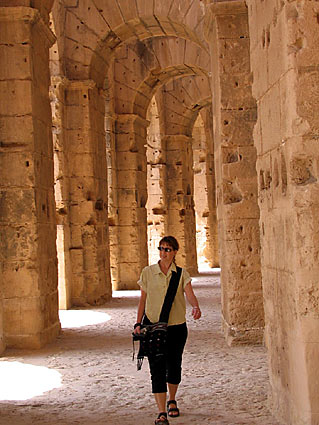
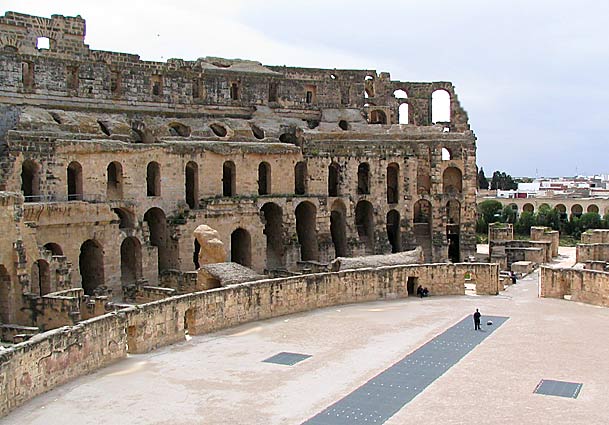
One place that has no need or desire for the tourist dollar is Sfax. It has grown on the riches of Phosphate which is mined deep in the interior but which is shipped from here. Also the millions of olive trees that dominate the interior of the Sahel region. Sfaxians are famous throughout the country for their business acumen and are known as ‘the Jews of Tunisia’. Perhaps a compliment or perhaps not. Despite that, the medina is worth a wander, having many of the goods to be found elsewhere in the country
but at much cheaper prices. Despite their business acumen the Sfaxians are less inclined to rip the tourists off. For us however the main reason to come to Sfax was to catch the ferry to the Kerkennah islands. But that’s the subject of the next post…